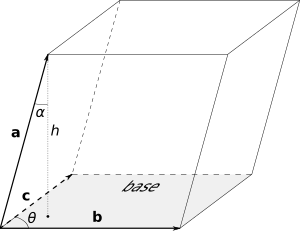Parallelepiped facts for kids
A parallelepiped is a 3D shape that has six faces. Each of these faces is a parallelogram. Think of it like a squished box! Just as a cube is related to a square, or a cuboid (a rectangular box) is related to a rectangle, a parallelepiped is related to a parallelogram.
Here are a few ways to think about what a parallelepiped is:
- It's a shape with six faces, and every face is a parallelogram.
- It's a shape with three pairs of faces that are parallel to each other.
- It's like a prism where the base shape is a parallelogram.
Some common shapes you might know are actually types of parallelepipeds:
- A cuboid (a rectangular box) is a parallelepiped where all six faces are rectangles.
- A cube is a special cuboid where all six faces are squares.
- A rhombohedron is a parallelepiped where all six faces are rhombuses.
Contents
Cool Features
A parallelepiped has some neat features. It has three sets of four parallel edges. All the edges in each set are the same length. Imagine a box; its top and bottom edges are parallel, and the front and back edges are parallel, and so on.
You can also use many identical parallelepipeds to completely fill a space without any gaps. This is called a space-filling tessellation.
How to Find the Volume
To find out how much space a parallelepiped takes up (its volume), you can use a simple formula:
- Volume = Area of the Base × Height
The "base" can be any of its six faces. The "height" is the straight distance from that base to the face directly opposite it. It's like finding the volume of any prism: you find the area of its bottom and multiply it by how tall it is.
If you have a tetrahedron (a pyramid with four triangular faces) that shares three edges with a parallelepiped, the tetrahedron's volume will be exactly one-sixth (1/6) of the parallelepiped's volume.
Special Kinds of Parallelepipeds
There are many different kinds of parallelepipeds, some of which have special properties:
- A rectangular cuboid (or just a cuboid) is a parallelepiped where all its faces are rectangles. Think of a brick or a shoebox.
- A cube is an even more special cuboid where all its faces are squares. All its edges are the same length.
- A rhombohedron is a parallelepiped where all its faces are rhombuses. A rhombus is a four-sided shape where all sides are equal in length, but the angles don't have to be 90 degrees (like a square).
Perfect Parallelepiped
A perfect parallelepiped is a very special kind of parallelepiped. It's one where all its edge lengths, the lengths of the diagonals on its faces, and the lengths of its main diagonals (that go through the middle of the shape) are all whole numbers.
For a long time, people wondered if such shapes even existed! But in 2009, many perfect parallelepipeds were found. For example, one perfect parallelepiped has edges that are 271, 106, and 103 units long.
Scientists are still looking to see if there's a perfect parallelepiped where all its faces are rectangles. If they found one, it would be called a perfect cuboid.
Where the Word Comes From
The word "parallelepiped" might seem long and tricky to say! It comes from ancient Greek words. "Parallel" means lines or planes that are always the same distance apart. "Epi-" means "on," and "pedon" means "ground" or "plane." So, "epiped" means a flat surface or plane.
Put it all together, and "parallelepiped" basically means a shape with parallel flat surfaces. This makes sense because its opposite faces are always parallel to each other.
See also
 In Spanish: Paralelepípedo para niños
In Spanish: Paralelepípedo para niños
Images for kids



